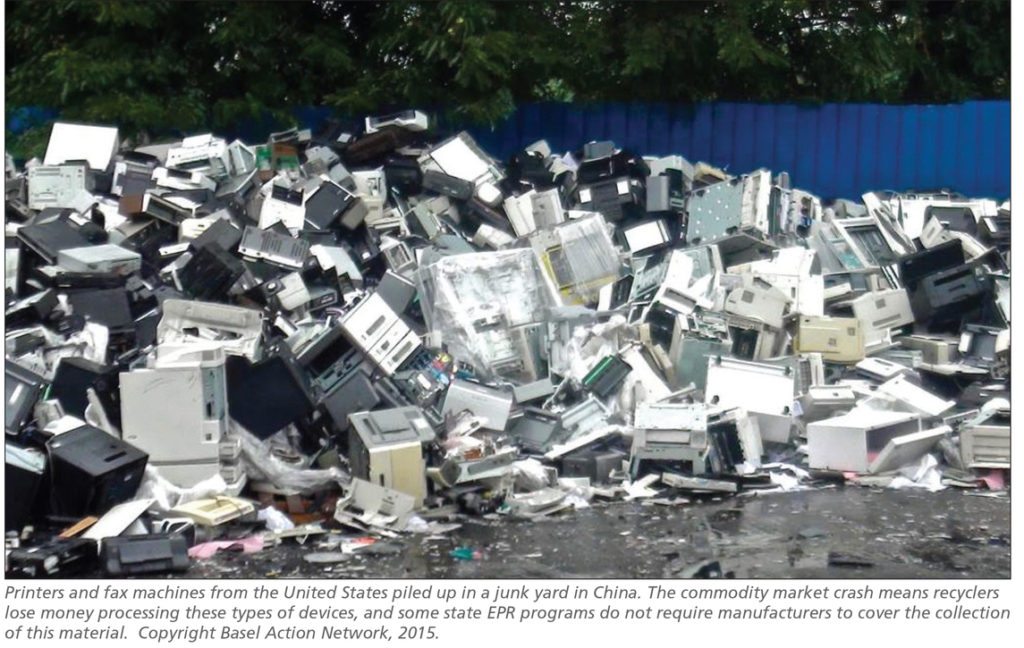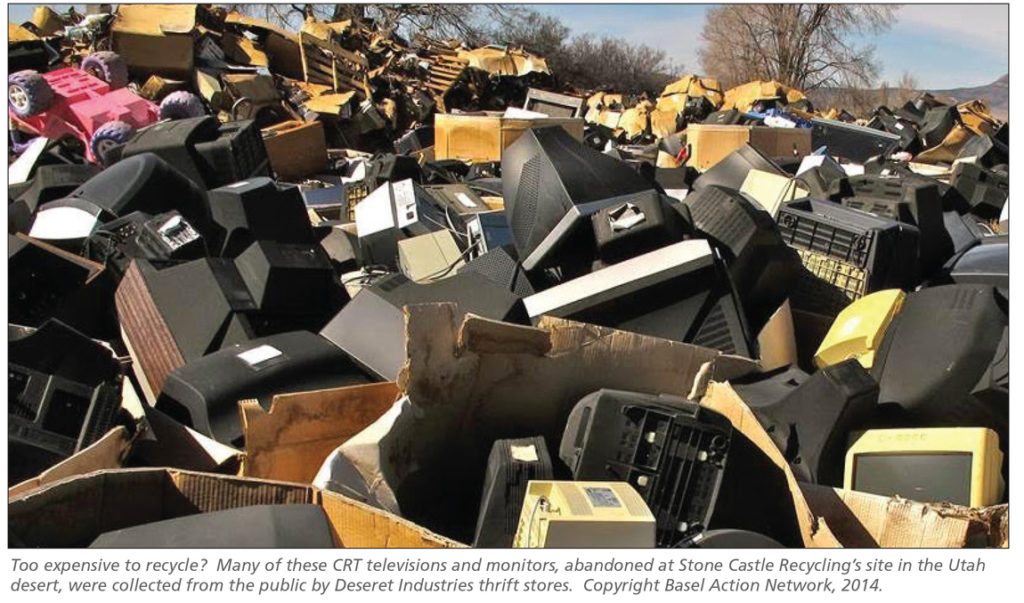This story originally appeared in the March 2016 issue of E-Scrap News.
Subscribe today for access to all print content.

In the last two years, and particularly the past six to eight months, have been extremely tough for most electronics recyclers in this country. The economics of recycling have dramatically shifted, leading recyclers to change business models toward refurbishment, cease business altogether or resort to unscrupulous activities to stay alive.
There are three primary factors that have pushed the electronics recycling industry into crisis mode:
Global commodity prices tanked
While the prices for metals and plastics that a recycler can recover from electronics were already low in the last few years, the bottom recently dropped out of these markets. This has dried up the primary source of income for most electronic recycling businesses, many of which had stopped charging customers upfront for electronics recycling services back when commodity values were high and manufacturers and other customers wanted to pay little to nothing for recycling.
The commodities crash is partly due to China’s overproduction and slowing economy, which have reduced demand for recycled materials in manufacturing and pushed the price of steel lower than the price of cabbage, according to a Sydney Morning Herald story last July.
The low commodities prices are also due to the continued drop in oil prices. Crude oil prices have fallen 70 percent since 2014, taking with them the prices for virgin plastics and other materials. This development has caused the market for recycled plastics to begin to evaporate. Some recyclers have been told they may need to actually pay to get rid of e-plastics in the near future rather than selling them as commodities.
Little value in consumer products
The second factor leading to e-scrap profitability struggles can be seen by simply disassembling many of the most common items in the stream today. A great number of electronic products now cost recyclers more to disassemble and process than they can earn by selling the commodities. Costs build up in labor, hazards, transportation, security and more. Some in the industry say it’s now impossible for a recycler to remain viable if its business model focuses solely on shredding or disassembling end-of-life consumer electronics as opposed to refurbishment.
The most problematic devices coming into the e-scrap stream contain toxic materials, hold little value and/or are very challenging to recycle. Here’s a brief rundown of the challenging items:
CRTs: The most extreme example is CRT TVs and monitors, which are very expensive to responsibly process due to their lead, cadmium and silica content. But they are still coming into the stream in large volumes.
Mercury-containing flat-panel TVs and monitors: There is money to be made reusing fully functional flat panels, but when these units are at end-of-life, the processing is expensive. Unless special shredding technology is used, all mercury lamps should be manually removed and sent to special mercury processors. To reach the lamps, the entire unit must be disassembled, which raises labor costs and risks. Unfortunately, many broken mercury flat panels are instead being exported to developing countries, usually in violation of existing international law.
 Peripherals: A large volume of products coming back for recycling can be classified as peripherals. These are items that plug into computers or TVs, including printers, fax machines, scanners, VCRs, DVD players, set-top boxes, keyboards and more. Made of plastic and low-value circuit boards, they lack the higher value metals found in computers, servers and laptops. Even several years ago, most of these items were barely worth recycling from a cost perspective, and the commodity crash has severely darkened the financial picture for these products. In addition, many state programs do not cover them.
Peripherals: A large volume of products coming back for recycling can be classified as peripherals. These are items that plug into computers or TVs, including printers, fax machines, scanners, VCRs, DVD players, set-top boxes, keyboards and more. Made of plastic and low-value circuit boards, they lack the higher value metals found in computers, servers and laptops. Even several years ago, most of these items were barely worth recycling from a cost perspective, and the commodity crash has severely darkened the financial picture for these products. In addition, many state programs do not cover them.
Tablets and smartphones: Many of the newest tablets and smartphones are designed with batteries glued in, covers glued shut and other features that complicate disassembly, making the labor costs higher than potential earnings from commodity sales. At a minimum, batteries must be removed before the products get shredded or smelted. Recyclers that have developed a reuse business are surviving by refurbishing these products or selling parts for reuse. Often, however, companies are exporting broken tablets and phones with dead batteries to developing countries, frequently in violation of the Basel Convention.
Squeezed by manufacturer programs
The third reason for the crisis in e-scrap economics is a shortfall in funding from original equipment manufacturers (OEMs). Many recyclers tell us that manufacturers simply don’t pay them enough to responsibly manage products covered in the programs that OEMs are required by law to support. Some recyclers, in fact, are no longer participating in state programs because of this problem. This has been a trend over the last few years and one we’ve heard a lot about in relation to CRT glass recycling. But the problem extends through the entire consumer-product stream.
Many manufacturers pit recycler against recycler, pushing prices below viable levels and effectively offering incentives for mismanagement of end-of-life electronics. We have heard reports of “reverse” online auctions, where recyclers compete for a manufacturer’s business by bidding lower and lower prices per pound, just to get the volumes. As recent processor closures and bankruptcies demonstrate, this activity is not a sustainable form of business.
The payment approach of OEMs has nearly destroyed some in the end-of-life recycling industry. Those managing to keep afloat have shifted to refurbishment primarily, but ultimately manufacturers need to pay recyclers enough to profit while responsibly handling the stream coming in.
Are any responsible companies left? Yes. Although the end-of-life industry is shrinking, there are a few e-scrap processors that are committed to protecting human health, the environment and our data, but how much longer can they survive?
Can’t be left to whims of the market
Despite the current market conditions, it’s imperative that used electronics continue to be responsibly recycled – and not landfilled, exported to developing countries, or dumped by the roadside. Why?
First and foremost, toxic materials lurk inside all of these products. Electronics contain “immortal” heavy metals, such as lead, cadmium and mercury. In addition, they often contain brominated flame retardants and other technologies that rely on a class of chemicals that are extremely slow to break down in the environment and therefore bio-accumulate in the food chain and elsewhere. Any options other than handling by responsible recyclers and their responsible downstream vendors will very likely result in these materials harming people and the environment – here in the U.S. or somewhere downstream.
Second, we need these metals and plastics to be recovered and reused. These are still non-renewable materials, even if today’s commodity prices are making virgin materials look better at the moment. Long-term sustainability goals must outweigh short-term market conditions. And someone needs to pay for recycling this problematic waste stream.
That someone should be customers and manufacturers, not recyclers.
 We need solutions that work even when the commodities market is down, solutions that don’t shift the problem onto recyclers, pressuring them to choose between the low road or going out of business. We continue to believe that the producers should take responsibility for their products when consumers are finished with them.
We need solutions that work even when the commodities market is down, solutions that don’t shift the problem onto recyclers, pressuring them to choose between the low road or going out of business. We continue to believe that the producers should take responsibility for their products when consumers are finished with them.
Twenty-three states have passed extended producer responsibility (EPR) laws. The point of such policy was to drive manufacturers to internalize the cost of collection and recycling into the price of the new product. But it’s clear most manufacturers are not doing this – they otherwise wouldn’t be squeezing recyclers so much on price.
We recommend the following actions:
Manufacturers internalize the full cost of collection and recycling of their products into the retail prices that consumers pay. These costs should be recorded as future liabilities for the manufacturers and maintained on the company books and balance sheets, where they are visible to shareholders and the SEC and where they can’t simply be erased as priorities change. While we call it “producer responsibility,” clearly the consumers – not taxpayers – ultimately pay these recycling costs. They pay when they buy new products, not at the time they are disposing of them. Fees have proven to be obstacles to recycling so we should not be expecting such an arrangement to fund responsible handling of end-of-life material.
Manufacturers immediately renegotiate low-priced contracts with recyclers. Many recyclers are in the midst of multi-year contracts with manufacturers, and perhaps other e-scrap generators, that were signed when the commodities market was much better Now they are stuck with money-losing contracts and are facing an existential crisis. Manufacturers should voluntarily reopen all of these contracts and revise them to levels that assure responsible handling of these toxic products. Going forward, contracts should include clauses to allow for adjustments when commodities drop or other factors dictate such action.
States pay more attention to prices paid for recycling. Only a few of the state EPR laws allow the state to set or approve the prices paid for recycling electronics. Others leave it up to manufacturers to dictate to recyclers, or sometimes negotiate. Clearly, some manufacturers are paying too little to cover responsible recycling and recyclers must either lose money, cut costs by using less-than-responsible practices, stop recycling material, or go out of business. At a minimum, states should require disclosure from manufacturers on prices paid to recycling vendors to guide state auditing and oversight activities.
Manufacturers design products to be easier to disassemble for recycling and reuse. While manufacturers can’t control commodity prices, they can control design of their products, and they must design for recycling and recovery.
Providing a vital service
We have a national problem – a hazardous e-waste stream with no national system for dealing with it. And due to changes in the global economy, the scrap electronics recycling industry is now being crushed.
We can’t let that happen. The e-scrap industry is providing an environmental and data security service, and companies in the sector must be able to set their prices in order to stay alive, protect their workers and reduce impacts on the global environment we all depend on.
Barbara Kyle is the national coordinator of the Electronics TakeBack Coalition. She can be contacted at [email protected]. Sarah Westervelt is the e-Stewardship policy director for the Basel Action Network (BAN) and the e-Stewards program. She can be contacted at [email protected].

